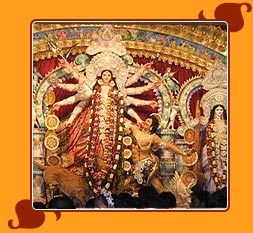The azure sky with fleecy white clouds and
the nip in the air marks the advent of autumn – the season for Bengal’s
most popular festival, Durga Puja or the worship of Goddess Durga. Durga
Puja is celebrated with customary pomp and fanfare twice a year – once
in the month of March or April (basant) and again in the month of September
or October (ashwin), during the moonlit fortnight. On both the occasions,
the puja is a nine-day affair with the last day coinciding with Ram Navmi
and Dussehra respectively. The Mother Goddess is venerated in one form or
the other all over India, though her popularity is at its peak with the
Bengalis.
 Goddess
Durga Worship
Goddess
Durga Worship The right time for the worship of Goddess Durga being in
spring, the prayers of Lord Rama are also known as akal bodhan (untimely
worship). Nowadays, Ram Navmi is celebrated during spring and Durga Puja or
Dussehra is celebrated during autumn. Prevalent in Bengal is the tale of the
defeat of the demon, Mahishasura at the hands of Goddess Durga, the
incarnation of Shakti, or Power.
This demon was almost invincible
because of a boon granted by Lord Shiva (the Destroyer in the Hindu Holy
Trinity of Creator-Preserver-Destroyer) whereby no male could defeat him.
But the gods found a novel solution to the daunting problem.
Mythological
Tales Associated With Durga Puja The festival of Durga puja comes
with its own retinue of mythological stories. The most prevalent among them
is the one involving Lord Rama, the hero of the Hindu epic, Ramayana. When
Ravana (the 10-headed demon king of Lanka, now Ceylon) abducted Lord Rama’s
wife Sita, and held her hostage in Lanka, a fierce battle ensued.
Although
there were huge casualties on both sides, Ravana could not be defeated. So
Rama decided to seek the blessings of Shakti or Goddess Durga in order to
defeat the 10-headed demon. But here comes the twist in the tale. 108 black
lotuses were needed for the worship of the Divine Mother and Rama had
managed to procure only 107. He was on the verge of laying one of his eyes
that was lotus-shaped and black in colour at the Goddess’s feet when
Shakti, satisfied with the measure of his devotion, granted her blessings.
and the righteous eventually triumphed.
Flashes of
the Past However, according to another legend about Durga, she was
a manifestation of Parvati, Shiva’s consort. It seems that while
Parvati existed only for Shiva, Durga was the form of Parvati’s shakti
(power) that was created solely for destroying demoniac forces. Close to the
heart of almost every Bengali is the image of Durga as the daughter who
visits her parents annually.
Her children Lakshmi (Goddess of
Wealth), Saraswati (Goddess of Knowledge), Ganesha (God of Prosperity) and
Kartikeya accompany her on this visit. Each year, there is great rejoicing
at the time of her homecoming, but the air is tinged with sadness on the day
one bids adieu to the deity. Perhaps people identify more intimately with
the human face of the omnipotent Goddess.
The Fiesta
Starts Durga Puja commences on the day after mahalaya, usually on
the last day of the waning or new moon, sometime in September or October. On
mahalaya, melodious strains of agomoni (welcoming) and chandi path (readings
from chandi, a religious Hindu text) exude from radios and television sets.
The countdown to the final days of the Puja itself begins from the day of
mahalaya. This is around the period when people indulge in last minute
shopping sprees. So if you don’t like crowds, this is not the time to
visit markets, especially in Bengal.
The Grand
Celebration Durga Puja is celebrated on a mass scale with puja
pandals (marquees) dotting nearly every nook and corner of West Bengal.
Thanks to a migrant Bengali population, the past few years have seen a rise
in the number of Durga Pujas in other parts of the country and abroad as
well. Preparations for the Puja begin long before the actual day arrives.
If you are looking for bargains, you won’t find a better
time. Publishing houses come out with puja editions of magazines, and
craftsmen and artisans do brisk business at this time of the year. During
the four days of Durga Puja, Bengalis really let their hair down. Beside the
actual Puja, most pandals organise different kinds of competition to regale
the local people. It’s party time for both children and adults alike as
they participate wholeheartedly in the fun and frolic. Local talent gets a
chance to share the stage (a makeshift one more often than not) with more
illustrious artists.
The festivities begin from maha shashthi (the
sixth day from the day after mahalaya) when the priest unveils the deity
during a puja known as bodhan. On this day the women of the house fast for
the well-being of the family. The fast is broken in the evening with fruits
and luchis (a kind of bread made of flour), usually eaten with sabzi
(vegetables). It is normal for the whole family to participate in these
rituals, especially when it comes to partaking of the yummy luchis and
sabzi. A trip to the local pandal is also a must.
Bijoya
Dashami Coinciding with Dussehra is bijoya dashami, the last day of
the Pujas. Married women bid farewell to the Mother Goddess through various
rituals, entreating her to come back every year. The playful ritual called
sindoor khela during which women smear each other’s hair, faces and
bangles with vermilion powder, breaks the solemnity of the occasion. Later,
all the idols are taken to nearby rivers or ponds to be immersed. To an
outsider, this might seem like a colossal waste, but don’t forget, this
also ensures idol makers never go out of business.
Festivals in
India are occasions to catch up with friends and relatives, and this
festival is no different. The evening of bijoya dashami is reserved for
spending time with friends and family, with youngsters touching the feet of
the elders as a mark of respect. A description of bijoya dashami is
incomplete without mentioning the mouth-watering delicacies like sweets and
nimkis (a crispy treat made of flour) that are prepared by the women of the
house.






